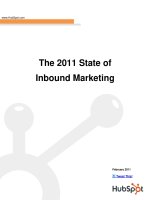REPORT hubspot state of inbound 2016
Bạn đang xem bản rút gọn của tài liệu. Xem và tải ngay bản đầy đủ của tài liệu tại đây (23 MB, 65 trang )
Global
4
2
Introduction
42
We Need to Talk:
Marketing and
Sales’ Disconnect
12
Today’s
Marketing and
Sales Priorities
48
18
Today’s
Marketing and
Sales Challenges
52
22
The Evolution of
Marketing and
Sales Priorities
58
32
Inbound’s Role
in Marketing
Effectiveness
72
How Different
Industries View
Inbound
38
Why Marketing and
Sales Alignment
Is Critical
80
Overrated
Marketing
Tactics
The Undeniable
Connection
Between ROI
and Budget
The State
of Sales
Technology
Global Inbound
84
100
106
110
118
122
The Future
of Marketing
The Future
of Sales
Where Decision
Makers Go for
Information
Reaching the
Right Audience:
How People
Connect Globally
Content: Who’s
Writing and How
Long it Takes
What People
Look For in
a New Job
3
When we first started looking at inbound, it mostly applied to finding out how to turn complete
strangers into website visitors. Shortly thereafter, it became about how you turn that visitor into
a qualified lead. As time went on, people began applying inbound to turn qualified leads into
delighted customers. And it was this step that changed everything.
Inbound means transforming how we do business to be more helpful, more human, more empathetic.
It focuses on the whole process of turning a stranger into a delighted customer. Inbound is about
matching the way you market and sell with the way people actually want to shop and buy.
We’ve seen a global movement grow around this philosophy of inbound -- one you may very well
already be a part of. This community of like-minded marketers and salespeople constantly elevate
one another, both personally and professionally, by sharing their expertise and insights.
The majority of our over 4,500 respondents are non-HubSpot customers hailing from marketing
backgrounds in B2B, B2C, small, and mid-sized businesses. Half of the companies represented here
generate under $1 million each year. With data collected from all corners of the map, this document
represents over 132 countries. A truly global community.
But where is that movement headed? What’s not only on the horizon, but miles beyond it? We’ve
always used the State of Inbound report as a barometer for current trends and where inbound is
headed directionally.
This year, we’re taking it one step further.
Welcome to our eighth annual State of Inbound
report. I might be biased, but I think this year’s
report is one for the books. Let me tell you why.
For the last eight years, we’ve surveyed thousands
of marketers and salespeople around the globe
about their challenges, priorities, and strategies in marketing and sales. The result is a
testament to the trends and growth of
inbound, something you’re unlikely
to find anywhere else.
We’ve taken these incredibly diverse insights to provide the current state -- and then predict the
future -- of inbound. So along with the benchmark data you’ve come to expect, this year, we’ve also
looked at new trends and technologies.
We may not have a crystal ball, but the 2016 State (and Future) of Inbound holds some of the most
informed predictions for the future of marketing and sales you’re likely to find.
The world is becoming more inbound. It’s growing more authentic, less
interruptive. And with the findings of this year’s report, I think it’s safe to say
that over the next ten years we’re going to see an even more inbound world.
Best,
Brian Halligan
CEO, HubSpot
4
5
Marketing Agencies 17%
Other 15%
IT & Services 13%
Education 7%
Software 7%
Consumer Products 6%
Media & Publishing 6%
Industrial & Manufacturing 5%
Healthcare & Medical 4%
Ecommerce 4%
Financial Services 3%
Travel & Tourism 3%
Nonprofit/Government 3%
Telecommunications 2%
Research 1%
Staffing & Recruiting 1%
Sports & Recreation 1%
Which of the
following best
describes
the principal
industry of your
organization?
606
704
SEA
(Southeast Asia)
243
Australia &
New Zealand
North America
15%
85%
HubSpot
customer or
agency partner
Not HubSpot
customer or
agency partner
33%
Consumers
5%
Nonprofit /
government
3%
Don’t know /
not applicable
Is your
company
any of the
following?
Where
are you
based?
1,228
EMEA
(Europe, Middle
East, Africa)
8
1,805
LATAM
(Central &
South America)
To whom
does your
company
primarily
sell?
59%
Other businesses
9
24%
How many full-time
employees does your
company have?
45%
Outbound
21%
17%
9%
8%
201 to 1,000
More
than 1,000
3%
Not sure
Fewer
than 10
What best describes
your company’s average
annual revenue?
What is your
organization’s
primary
approach to
marketing?
11 to 25
26 to 200
35%
15% 16% 11%
Less than
$250K
What best describes
your level in your
company?
$250K to
$999,999
$1M to
$99M
26%
$100M to
$499M
26%
2%
3%
$500M to
$999M
$1B or more
26%
14%
8%
73%
Inbound
10
C-level
executive
(CEO, CMO)
Vice president
/ director
Manager
Individual
contributor
Other
11
What are your company’s
top marketing priorities
over the next 12 months?
74%
57%
46%
42%
32%
Marketers today are focused on converting the
visitors they attract into leads and customers.
Next is growing traffic to their website,
followed by increasing revenue from
existing customers (upselling).
Clearly, the mandate marketers received
is: Keep the engine running with
a keen eye toward monetizing
their marketing activities.
12
Converting
contacts
/ leads to
customers
Growing
traffic
to website
Increasing
revenue
derived from
existing
customers
Proving the
ROI of our
marketing
activities
Sales
enablement
27%
Reducing
the cost of
contacts
/ leads /
customer
acquisition
13
Thinking specifically
about inbound marketing
projects, what are your
company’s top priorities?
Growing SEO / organic presence
Blog content creation
For specific inbound marketing projects, marketers
focus on growing SEO,
blog content creation, and
content distribution. Blog
content is marketers’ bread
and butter, with 60% focusing on blogs in their work.
Content distribution / amplification
Marketing automation
Interactive content creation
Long-form (ebooks, whitepapers)
Visual content creation (infographics)
Online tools
Product how-to videos
Webinars
What are your company’s
top sales priorities for the
next year?
Despite the fact that Sales is undergoing a radical transformation right now -- similar to the inbound revolution that
swept over Marketing a decade ago -- the function’s
primary directive is still the same: Sell more, better, faster.
Seventy percent of respondents are dead set on closing
more deals this year.
Just how many leads are salespeople closing into deals
What is the average
today? Currently, the average lead-to-customer conversion
percentage of leads your
rate is below 20% for almost half of respondents.
company converts to sales?
Closing more deals
10% or less
Improving the efficiency
of the sales funnel
11 to 20%
Reducing the length of the sales cycle
21 to 30%
Social selling
Training the sales team
Improving existing
sales technologies
Investing in sales enablement
23%
20%
18%
31 to 40%
41 to 50%
11%
8%
11%
Over 50%
Don’t know
9%
Investing in a CRM
Other
14
15
Social selling is a priority
for more salespeople in
2016 than ever before.
28%
22%
2015
16
2016
Social selling
17
What are your company’s
top marketing challenges?
Metrics driven challenges (amount of traffic and leads
generated and proving ROI) are the big challenges facing
marketers -- they still lack access to tools that can help
them track concrete results for their campaigns.
Marketers still lack access to tools that can help
them track concrete results for their campaigns.
Generating
traffic
and leads
18
Proving
the ROI
of our
marketing
activities
Securing Managing
enough
our
budget
website
Identifying Targeting
the right content for
technoloan intergies for
national
our needs audience
Training
our
team
Hiring
top
talent
Finding an
executive
sponsor
19
What part of the sales
process do reps struggle
with the most?
The part of the sales process salespeople are struggling
with most is prospecting. In addition, 20% of respondents
indicated that identifying the lead -- a new option in this
year’s survey -- was the biggest challenge at their company.
It’s clear that the beginning of the sales process is thorny
for reps, more so than the middle or the end.
Prospecting is more difficult
for Sales when prospects
aren’t knowledgeable about
their company’s services or
offerings.
33%
Just 26% of salespeople say prospecting is hard when their
lead is very knowledgeable about the salesperson’s product
or services. But when a lead is clueless about what the
salesperson is selling, the task of prospecting gets harder.
Marketers, take note. The best way to help your sales team
is to educate your audience.
35%
36%
26%
Identifying the lead*
Prospecting
Qualifying
20162015
How knowledgeable are
your prospects about your
company before your sales
rep makes the first contact?
Closing
*Option was not given in 2015 survey.
18%
Why is prospecting so painful? One reason might be buyers’
lack of knowledge about the products or services our sales
respondents are selling. A full 63% of survey takers indicated
that prospects are “somewhat” or “not at all” knowledgeable
about their companies before a sales rep makes first contact.
38%
26%
25%
8%
3%
20
Very
knowledgeable
Moderately
knowledgeable
Somewhat
knowledgeable
Not at all
knowledgeable
Don’t know
Very
knowledgeable
Moderately
knowledgeable
Somewhat
knowledgeable
Not at all
knowledgeable
“Prospecting is difficult when my lead is...”
Don’t know
21
What are your company’s
top marketing priorities
over the next 12 months?
Rank
2015
2014
2013
Converting
contacts
/ leads to
customers
Increasing
number of
contacts
/ leads
Increasing
number of
contacts
/ leads
Reaching
relevant
audience*
Grow traffic
to website*
Converting
contacts
/ leads to
customers
Converting
contacts
/ leads to
customers
Converting
contacts
/ leads to
customers
Increasing
revenue
derived from
existing
customers
Increasing
revenue
derived from
existing
customers
Reaching
relevant
audience*
Increasing
total lead
volume*
Proving the
ROI of our
marketing
activities
Proving the
ROI of our
marketing
activities
Increasing
revenue
derived from
existing
customers
Creating
quality
content*
5
Sales
enablement*
Reducing
the cost of
contacts
/ leads /
customer
acquisition
Proving the
ROI of our
marketing
activities
Proving the
ROI of our
marketing
activities
6
Reducing
the cost of
contacts
/ leads /
customer
acquisition
1
2
3
4
22
2016
Priorities have stayed relatively static through the years.
Since leads tends to be the major metric marketers are
measured by, they continue to be a top priority.
Reducing
the cost of
contacts
/ leads /
customer
acquisition
*Option only available that year
23
Thinking specifically
about inbound marketing
projects, what are your
company’s top priorities?
Rank
1
2
3
4
5
6
7
8
9
24
When we look at inbound-specific priorities, growing SEO
has replaced blog content creation in the top spot. There’s
also movement further down the list. Webinars ranked high
in 2014 but dropped off in 2016.
2016
2015
2014
Growing SEO
/ organic presence
Growing SEO
/ organic presence
Blog content
creation
Blog content creation
Blog content creation
Growing SEO
/ organic presence
Content distribution
/ amplification
Content distribution
/ amplification
Content distribution
/ amplification
Marketing
automation*
Long-form / visual
content creation
Webinars
Interactive content
creation
Interactive content
creation
Long-form / visual
content creation
Long-form (ebooks,
whitepapers)
Online tools
Interactive content
creation
Visual content
creation infographics)
Webinars
Product how-to
videos
Online tools
Product how-to
videos
Online tools
Product how-to
videos
Freemium trials
Freemium trials
*New Option
25
What are your company’s
top sales priorities for
the next year?
We see some minor
shifts in sales priorities
year-over-year -- with the
biggest gain in the social
selling category (+6%)
Closing
more
deals
26
Improving Reducing
the
the
efficiency length
of the
of the
sales
sales
funnel
cycle
Social
selling
Training Improving Investing Investing
the
existing
in sales in a CRM
sales sales tech- enableteam
nologies
ment
20152016
Other
Don’t
know / not
applicable
27
Proving ROI has been a
consistent challenge for
Marketing.
Rank
28
1
2
3
4
5
6
7
2016
Generating
traffic and
leads*
In previous State of Inbound reports, we’ve found
measuring and proving ROI impacts the success
of a marketing organization and their future budget.
2015
2014
2013
Proving the ROI
of our marketing
activities
Proving the ROI
of our marketing
activities
Proving the ROI
of our marketing
activities
What is more difficult to
do in sales compared to
2 to 3 years ago?
On the sales side, getting a response is the biggest challenge
compared to a few years ago. A quarter of sales respondents
also face more complex purchases with multiple decision
makers involved in the sale. 14% also say using their sales
technologies has gotten more difficult -- this may reflect the
complexity of sales tools available today or the sheer number
of tools some sales representatives have to use.
Getting a response from prospects
Closing deals
Engaging multiple decision
Proving the ROI
of our marketing
activities
Securing
enough budget
Securing
enough budget
Managing our
website
Managing our
website
Securing
enough budget
Securing
enough budget
makers at a company
Identifying / prospecting good leads
Identifying
the right
technologies
for my needs
Controlling my
technology or
website
Controlling my
technology or
website
Targeting
content for an
international
audience
Targeting
content for an
international
audience
Avoiding discounting / negotiation
Incorporating social media into the sales
Connecting via phone
Using sales technologies
in my day to day job
Identifying
the right
technologies
for my needs
Training our
team
Hiring top talent
Targeting
content for an
international
audience
Targeting
content for an
international
audience
Training our
team
Training our
team
Hiring top talent
Finding an
executive
sponsor
Hiring top talent
Connecting via email
Doing research before making
initial call / writing initial email
Training our
team
Sourcing referrals
Keeping someone on the phone
Finding an
executive
sponsor
Delivering a presentation
Other
*New Option
29
What are your company’s
top marketing priorities
over the next 12 months?
If we dissect the responses of inbound and outbound
marketing teams, we see a few differences in how these
respective teams approach marketing. Overall, outbound
organizations are slightly more likely to focus on sales
enablement than inbound organizations — which are more
inclined to focus on leads and traffic growth.
What are your company’s
top marketing challenges?
Companies that described themselves as outbound shops
also seem to have slightly more trouble with proving ROI
(49% versus 42%), securing budget (33% versus 26%), and
training their team (23% versus 18%) compared to their
inbound marketing peers.
Converting contacts
/ leads to customers
Grow traffic to website
Increasing revenue derived
from existing customers
Proving the ROI of our
marketing activities
Reducing the cost of contacts
/ leads / customer acquisition
Sales enablement
InboundOutbound
What are your company’s
top inbound marketing
priorities over the next
12 months?
Compared to outbound teams, 24% more inbound
organizations will focus on content creation; 11% more
inbound organizations prioritize growing organic reach.
Growing SEO / organic presence
Blog content creation
Content distribution / amplification
Finding an
executive
sponsor
Marketing automation
Interactive content creation
30
InboundOutbound
Hiring top
talent
Training
our team
Targeting
content
for an
international
audience
Identifying
the right
technologies for
our needs
Managing
our
website
InboundOutbound
Securing
enough
budget
Proving
the ROI
of our
marketing
activities
Generating
traffic
and leads
31
Turns out, 61% of marketers think
their organization’s marketing
strategy was effective.
39%
61%
No
Yes
Do you feel
that your
organization’s
marketing
strategy is
effective?
Over the past few years, we’ve established the challenges
and priorities for marketing and sales teams in the State of
Inbound report. This year, we introduced a new angle in
our study: Do marketers believe in their organization’s
marketing strategy?
32
33
When we looked into the composition of
effective marketing organizations, we found
inbound organizations
were 4 times as likely
to rate their marketing
strategy highly.
Based on our data, inbound marketers are
much more likely to be satisfied with the
tactics their organizations are prioritizing.
34
35
81%
Based on your organization’s
approach to marketing, do
you feel that your marketing
strategy is effective?
We primarily conduct
inbound marketing
What are your company’s
top marketing challenges?
“Yes, my organization’s marketing
strategy is effective.”
Generating
traffic and
leads
Proving the
ROI of our
marketing
activities
Securing
enough
budget
We primarily conduct
outbound marketing
Identifying
the right
technologies for our
needs
Targeting
Training
content
our team
for an
international
audience
Hiring top
talent
Finding an
executive
sponsor
Many components contribute to a marketing team’s failure
to provide quality leads to Sales, but with a third of ineffective
marketing teams saying they have trouble managing their
own website, this barrier likely contributes to Marketing’s
failure to provide great leads.
Which source provides
the highest quality leads
for your sales team?
36
Managing
our
website
“No, my organization’s marketing
strategy is not effective.”
Perhaps lack of control or technical limitations to ineffective
teams’ websites also impacts lead quality. In a separate
question about the best sources of leads sales teams receive,
ineffective marketing teams were twice as likely to admit the
best leads were produced by sales compared to effective
teams. Just 17% of effective marketing teams ranked selfsourced sales leads as the highest quality leads for their
organization, compared to 35% of ineffective teams.
18%
“Yes, our marketing strategy is effective.”
When we looked at the challenges faced by marketing
teams, ineffective teams cited managing their website
as a challenge 10% more often than effective teams.
“Yes, my organization’s marketing
strategy is effective.”
Inbound practices
“No, my organization’s marketing
strategy is not effective.”
Self-sourced leads from
sales team
Outbound
practices
37
So we pivoted the data and checked to see how effective
organizations with SLAs are compared to those without
SLAs. The results are definitive.
Marketers in companies with SLAs also have more faith in
their marketing strategy. Smarketing has been a core tenet
of inbound for years -- and our data shows how critical it is
to Marketing’s success. Just 22% of our respondents have a
formal SLA between Marketing and Sales, and a further 44%
told us the two organizations were generally aligned.
44%
How would you
characterize your
company’s sales and
marketing relationship?
22%
Tightly
aligned (Sales
and Marketing
SLA)
14%
Generally
aligned
Rarely
aligned
11%
Misaligned
Inbound marketing philosophy works hand in hand with the
concept of smarketing, and our data shows that when the two
work in tandem, there is a higher chance for success. Of those
with an SLA, 82% said their marketing strategy was effective.
For those who said they were misaligned, only 20% thought
their marketing strategy was effective. The less aligned Sales
and Marketing are, the more negative the outlook.
The handshake between Sales and Marketing
tends to produce the most measurable
results for a marketing team.
Some typical key performance metrics are
number of leads sourced by Marketing
for Sales, number of marketing
qualified leads (MQLs) handed to
Sales, number of MQLs worked
by Sales, and number of
deals closed by Sales
that originated from
Marketing.
38
82%
Of company’s who say
their marketing strategy is
effective, how aligned is
their Sales and Marketing
relationship?
66%
36%
Tightly
aligned (Sales
and Marketing
SLA)
20%
Generally
aligned
Rarely
aligned
Misaligned
“Our marketing strategy is effective.”
39
Based on how you characterized your company’s
Marketing and Sales
relationship, do you
feel that your marketing
strategy is effective?
For our survey respondents, the most powerful combination
of characteristics for an effective marketing organization
is to 1) be inbound and 2) have an SLA between Sales and
Marketing. Inbound organizations with SLAs are over 5
times as likely to rate their marketing strategy as effective
compared to outbound organizations with misaligned
marketing and sales teams.
How does your
company’s current
budget for inbound
marketing compare
to last year’s?
Effective strategies obviously produce results, and our data
shows those who feel confident in their marketing strategy
are over 2 times as likely to get higher budgets for their
marketing teams.
72%
85%
84%
Higher
58%
Outbound and
misaligned
Inbound with SLA
45%
No Change
55%
Lower
42%
28%
15%
Outbound and
misaligned
“Our marketing strategy is effective.”
40
16%
Inbound with SLA
“Our marketing strategy is not effective.”
“Our marketing strategy is effective.”
“Our marketing strategy is not effective.”
41
When we asked marketers where they got their best leads,
the majority said inbound-sourced leads were the highest
quality. However, salespeople who participated in our study
rated marketing-generated leads last, behind self-sourced
leads and referrals.
Marketers, which source
provides the highest quality
leads for your sales team?
Salespeople, which is the
top source of leads for
your sales organizations?
59%
38%
36%
24%
22%
17%
There’s always room to improve the handoff between
Marketing and Sales, and our data shows marketing
and sales teams need to continually communicate and
refine their SLA, even if there’s already one in place.
Inbound
practices
42
Self-sourced
leads from
sales team
Outbound
practices
Leads directly
sourced by
Sales
Referrals
Leads from
Marketing
43
How would you rate
the quality of the leads
you receive from the
following sources?
Breaking down scores on a more granular level, a full
70% of sales respondents gave marketing-generated
leads a 3 out of 5 or less.
Which source provides
the highest quality leads
for your sales team?
(by seniority)
The marketers who recognize Sales values the leads they
individually source are realistic and pretty darn perceptive.
When we asked sales professionals where the best leads
came from, they rated the ones sourced from Marketing
dead last.
When we cut the responses by seniority, we find that senior
sales leaders actually value referrals the most. All other
groups consistently rated Sales-sourced leads the highest.
Marketing
Sales
Referrals
1 Very poor quality
2
3
4
5 Very high quality
C-level
executive
Vice
president
Director
Manager
Individual
contributor
Referrals MarketingSales
Based on your organization’s primary marketing
approach, which source
provides the highest
quality leads for your
sales team?
The difference in where quality leads comes from is
pronounced when we compare inbound and outbound
marketing teams. 73% of inbound marketers say the best
leads originate from inbound practices, compared to just
18% of outbound marketers. Given the different focuses
of the cohorts, their differences are expected. What is
interesting is that 20% of inbound marketers and 33% of
outbound marketers admit that the best leads are sourced
directly by Sales.
“We primarily
conduct inbound
marketing.”
Based on your company’s
Marketing and Sales
relationship, which source
provides the highest quality
leads for your sales team?
“We primarily
conduct outbound
marketing.”
Tightly aligned
(Sales and
Marketing SLA)
44
Inbound practices
Outbound practices
Clearly, the leads sourced by Marketing aren’t favored by
Sales, even if Marketing is none the wiser. So we broke
down Sales’ ratings of leads against Marketing and Sales
alignment and found that sales organizations with SLAs
were more likely to rate leads from Marketing higher.
When Sales and Marketing have agreements in place that
1) defines a good marketing lead and 2) guarantees a work
rate from Sales, the two groups work better together.
Self-sourced leads from sales team
Generally aligned
Rarely aligned
Referrals MarketingSales
Misaligned
45
communication.
At the end of the day, it comes down to
There’s room for improvement on Marketing-sourced
leads, but Marketing won’t know what needs to be
fixed unless there’s a feedback mechanism built
into the Marketing and Sales relationship. Whether
it’s truly the case that Marketing is failing to deliver
enough quality leads to Sales or not, marketers
should be aware of salespeople’s low opinion
of their work, and take action accordingly.
46
47
How does your company’s current
budget for inbound marketing
compare to last year’s?
Higher
No change
49%
Lower
37%
30%
Measuring ROI has been a top challenge for marketers
over the years, yet we consistently find that being
able to prove ROI is crucial to a marketing team’s
success. Those who can calculate ROI are 1.6x
as likely to receive higher budgets.
9%
8%
Calculate ROI
48
27%
Don’t calculate ROI
49









